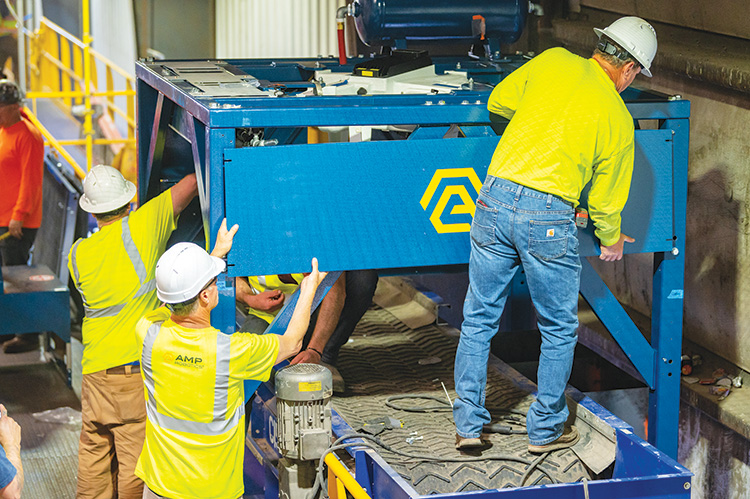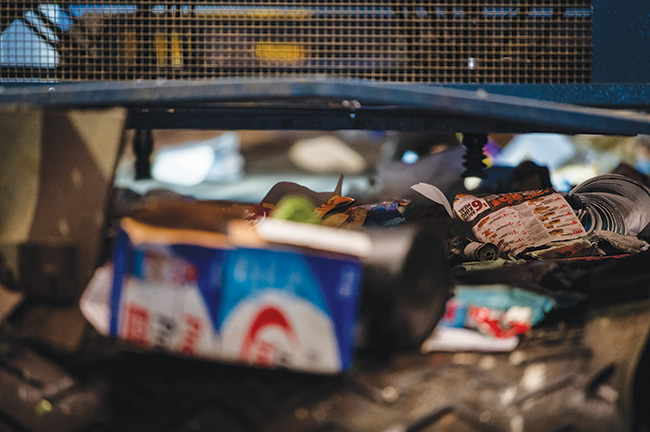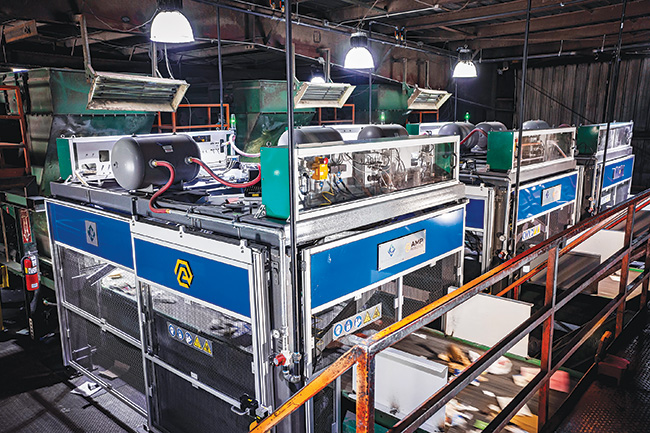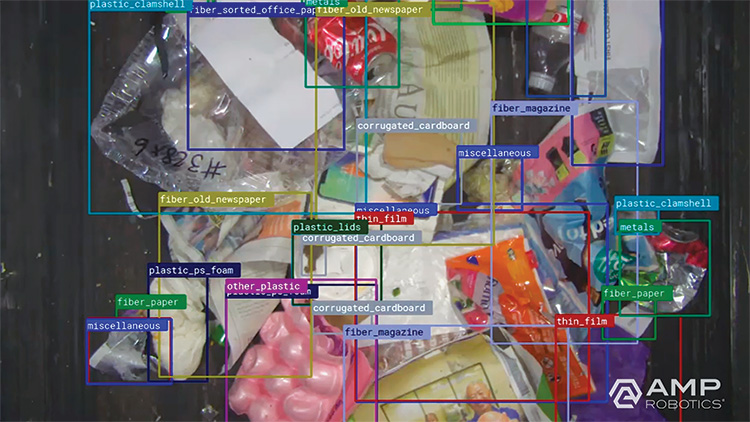As the industry responds to the commitments made by consumer-packaged goods companies to use more post-consumer recycled content, the demand for robotics to modernize existing recycling facilities continues to thrive.
By Jonathan Levy
The story of the recycling industry is one of constant change and innovation. Regardless of the challenge, recyclers have risen to meet it. Recently, experiences with labor shortages and economic conditions have prompted recyclers to embrace advanced technologies such as artificial intelligence and robotics. As a demonstration of the pace of adoption, AMP Robotics installed its first robot in late 2016, and today, our fleet of approximately 275 robots is distributed across three continents.
Consistency Driving Higher Quality
This automation is driving a new wave of efficiency and consistency. To remain competitive, many materials recovery facilities (MRFs) have found they need solutions that can operate 24/7. Robots powered by artificial intelligence can operate around the clock—if the recycler is open for business, you can find the robot hard at work sorting all the items that flow through the stream. In addition to constant, consistent operations, these robots can work double or triple the speed of the best human sorter. This consistency also drives higher quality in recovered commodities. Robots are flexible; the systems can be adjusted to reflect material stream changes, commodity prices, and more. Robots can work in areas and on materials where volumes do not warrant a human sorter because it can multitask and target a variety of materials in lieu of just one or two. What’s more, these systems can usually be installed over a weekend, reducing downtime, and allowing the recycling facility to continue operating without experiencing the significant loss of revenue associated with prolonged closures.
For many customers, the addition of robots has allowed them to shift staff to higher-skilled positions within the facility—roles in maintenance, as equipment operators, or as route drivers. One customer, Emmet County in Michigan, saw a 60 percent improvement in labor efficiency after deploying three AI-guided robots. Due to the robots’ speed and precision, it takes significantly less time to process material when compared to a human. Robots, at a pace close to 90 picks per minute, are accomplishing in three hours what would normally take human sorters a full eight-hour day.

Accessing Technology
Robots can be deployed quickly—usually over the course of a weekend—to minimize line interruptions or the need for costly downtime. The technology has a short payback period, and there are also leasing options available that offer interest-free financing without an upfront payment. Programs like these enable waste management and recycling businesses to get the benefits of sorting automation without the capital expense.
In seeing the opportunity to improve efficiency, government entities and private organizations alike are providing recyclers with opportunities to modernize their facilities through funding opportunities such as targeted grant programs. One such opportunity is available through The Recycling Partnership’s Polypropylene Recycling Coalition, which provides grants to improve the capture of polypropylene. Cedar Avenue Recycling and Transfer Station (CARTS), a Caglia Environmental company, is a MRF that took advantage of the funding available through The Recycling Partnership to acquire an AMP robot dedicated to polypropylene recovery. CARTS decided to purchase two additional robots after seeing how AI and robotics technology could improve recovery of additional plastics and other recyclables.

The Brains of the Operation
While the robot may get much of the attention, the “brains” of the operation—specifically the artificial intelligence directing the robot what to do—is what makes the system so efficient and adaptable. AI works by comparing hundreds, if not thousands, of examples of an object and then learns to recognize that object. AI is continuously trained on new types of packaging as brands and manufacturers introduce them into the recycling stream and deploys the learnings to the entire installed base. Throughout our fleet of installations, the AI network identifies approximately 6.6 billion and recycles close to 215 million items each month. The vast amount of material being identified, categorized, and handled proves that most of the materials found in a curbside stream can be sorted and processed. The ability to train AI on new packaging types and formats and transmit that information fleetwide will allow the industry to keep up with the breakneck pace of innovation packaging producers and manufacturers are releasing to store shelves. If an item can be sorted, then the recycler has an increased array of options on what to do with that item. The notion of “hard-to-handle materials” should be relegated to the waste bin.
On the operational level, the data AI generates can help recyclers scrutinize their operations and determine where inefficiencies throughout the facility are occurring, then take instantaneous action to rectify them. For example, if a MRF operator is expecting to process PET at a certain rate per hour and is not meeting that level, our web portal for near real-time recycling data and insights can trigger a material composition alert, and he or she can investigate where the problem is occurring. A regional municipal MRF that was losing recyclables to the landfill used this web portal to determine that it could recover 51 percent of its inbound stream with an annual market value just shy of $200,000. This use of data validated the case to add another robot to the facility to increase recovery and prevent loss to landfill. Using operational-level data in this way is making facilities more efficient and profitable.

Centralizing Data
Material characterization solutions provide actionable, data-driven insights throughout the facility and provide the tools necessary to centralize data collection and reporting. Users can generate custom reports, create custom operational alerts, review upstream equipment performance, and transfer data to business analytics tools.
As mentioned earlier, it is important that recycling facilities can adapt to the challenges of an ever-evolving packaging stream. Many facilities were designed based on the types of materials prevalent at the time of their groundbreaking. AI and robotics systems can profoundly change the way MRFs recover materials because they are adaptable to the material stream, providing unlimited flexibility in handling new packaging types as they emerge or in shifting target materials for recovery based on commodity prices. This helps “future proof” MRFs and increases their overall lifespan.
While the adoption of artificial intelligence and robotics has provided immense advantages on the operational level, these systems will also revolutionize the way policy makers look at the recycling industry. Over the past two years, four states—Maine, Oregon, Colorado, and California—have passed laws related to Extended Producer Responsibility (EPR) for packaging, and many other states are considering EPR-related bills. As these programs continue to ramp up across the country, the producer responsibility organizations (PROs) as well as the regulators tasked with overseeing these programs will be faced with an immense challenge. That is, how they will collect, process, and make sense of the vast array of packaging types, brands, and packaging for which manufacturers are responsible. Because AI platforms are already hard at work identifying and categorizing the material coming down the line, it is logical to tap this data stream for information the PRO needs to generate the reports required by EPR legislation.

Real-Time Monitoring
Currently, states and localities use manual hand sorts to count and characterize the types and amounts of material flowing through the recycling stream. These studies can prove costly and are subject to human error and lack of transparency and accuracy. Automated, anonymous, and consistent real-time monitoring of material flowing through a recycling facility can give an exact and accurate picture of the types of materials being recycled while providing the data needed to ensure the curbside program is working as designed. This eliminates the need for a traditional bale audit and reduces the recycler’s overall operational costs as well as costs to administer the program.
Armed with this information, recyclers and communities can work together to reduce the amount of contamination introduced into the curbside program and increase public education and outreach that will resonate with participants. For example, if a MRF receives too many contaminants, the operator can share this data with the municipality. This feedback can help the community undertake public outreach efforts regarding what is and is not allowed in the program, focusing specifically on the most disallowed items. Targeting specific contaminated items commonly found in the stream may resonate more with the community than generic, broad-based messaging.
Growth and Opportunity
As the industry responds to the commitments made by consumer-packaged goods companies to use more post-consumer recycled content, the demand for robotics to modernize existing recycling facilities continues to thrive. With these retrofits, we see growth and opportunity in several areas—from the breadth and precision of material characterization capabilities, to increasing use of data to improve recycling operations, to helping policy makers achieve sustainability targets. This new wave of opportunity and innovation through the implementation of AI and robotics is simply the next chapter in the story of an industry that has continuously adapted and thrived regardless of the challenges it has faced. | WA
Jonathan Levy is Director of Government Relations for AMP Robotics. In this role, he develops government outreach strategies and works with coalition partners across the recycling value chain to develop policies that support and advance the industry. Jonathan has more than 20 years of experience in government affairs and, before joining AMP, spent 15 years at the Institute of Scrap Recycling Industries (ISRI), where he served as the liaison to ISRI’s Plastic, Tire, Materials Recovery Facilities, and Education and Training Committees, helping members translate their ideas into tangible deliverables. Earlier in his career, he worked for the American Institute of Architects and as the legislative assistant to a New York State Assemblywoman. He can be reached at [email protected].
